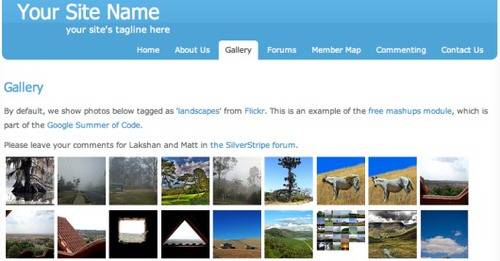Content Management Systems (CMS) aren’t the most sexiest applications in the world. When you think CMS, you probably think Vignette, Interwoven or a similar enterprise-level product. Those systems are usually bulky and difficult to use. At the other end of the spectrum are blogging platforms, such as Movable Type or WordPress, which are renown for being fairly lightweight and easy to use – but often they lack the high-end functionality required in a CMS (content approval process, version control, reporting, etc).

In the middle of this spectrum (Enterprise CMS — Blog Platform) lies SilverStripe, an open source CMS system developed by a small company out of Wellington, New Zealand. It has a simple web interface and was built using PHP5, an alternative developer framework to the more hyped web 2.0 framework Ruby on Rails. SilverStripe was recently named as one of 5 finalists in the Most Promising Open Source CMS Award, part of the 2007 Open Source CMS Awards held by Packt Publishing.
Included amongst SilverStripe’s features are an e-commerce module and some web 2.0 mashups (e.g. Flickr, YouTube and Technorati). Check out their Modules page for full details. It also has the usual things you’d expect of a CMS (but don’t always get!), such as standards compliant code and scalability.
SilverStripe Admin

State of the CMS Market
I caught up with SilverStripe Chief Marketing Officer Sigurd (Siggy) Magnusson recently, to find out more about his company’s product and about the current state of the CMS market.
Siggy told me that the content management space is still immature. The bigger CMS systems like Vignette and Interwoven are going for the larger, enterprise market – and there are great open source choices too in this market, such as Alfresco. Meanwhile blog systems are becoming popular as CMS systems – notably Automattic’s WordPress and Six Apart’s Movable Type. But there is room for smaller CMS systems like SilverStripe to cater to the middle market, said Siggy. Indeed he described SilverStripe to me as in between WordPress and a CMS system like Mambo or Drupal.
So how does an open source CMS make money? Siggy replied that they make money by hosting and development services, but also a possible revenue stream is e-commerce commissions.
SilverStripe and Google Summer of Code
Another interesting thing about SilverStripe is that it recently got support from Google, in the form of being a part of the Google Summer of Code project (although in this part of the world it was a Winter of Code!). Summer of Code is a program that Google ran this year, to bring together “900 students and nearly 1500 mentors across 90 countries to contribute to over 130 different open source software projects.” SilverStripe was given 10 programmers, who helped to develop SilverStripe features and enhancements. One of those students was Elijah Lofgren, from Deatsville, Alabama. Elijah kept a journal of his work with SilverStripe as part of Google Summer of Code. In his wrap-up post, he wrote:
“My 2007 Google Summer of Code Experience has now come to a close. ItÄôs been great! IÄôve learnd a lot about AJAX & PHP5 and have thoroughly enjoyed making improvements to SilverStripe. 🙂
I spent approximately 50 days on SilverStripe work. So with about 300 hours, it comes out to about 6 hours a day. 🙂 If you are interested in reading my entire work log (warning, quite long!) see: /silverstripe/logs/silverstripe-google-summer-of-code-2007.html“
Another Summer of Code student, Markus Lanthaler, created an OpenID login for SilverStripe.
SilverStripe Flickr module

Conclusion
There are literally hundreds of CMS systems on the Web, targeting anything from small businesses to large enterprises. SilverStripe is one of those hoping to mine the large ‘in-between’ market of organizations looking for something more functional than a blogging platform, but not as complex as some of the traditional CMS systems.
Let us know of other small CMS systems that you like, in the comments. It’s a mostly ignored market segment in the world of web 2.0 blogs, so it’d be good to open up this discussion some more.

















